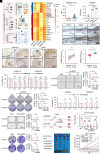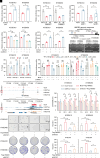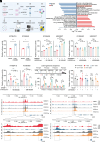Chronic stress-induced cholesterol metabolism abnormalities promote ESCC tumorigenesis and predict neoadjuvant therapy response
- PMID: 39869796
- PMCID: PMC11804521
- DOI: 10.1073/pnas.2415042122
Chronic stress-induced cholesterol metabolism abnormalities promote ESCC tumorigenesis and predict neoadjuvant therapy response
Abstract
Recent studies have demonstrated that chronic stress can enhance the development of multiple human diseases, including cancer. However, the role of chronic stress in esophageal carcinogenesis and its underlying molecular mechanisms remain unclear. This study uncovered that dysregulated cholesterol metabolism significantly promotes esophageal carcinogenesis under chronic stress conditions. Our findings indicate that the persistent elevation of glucocorticoids induced by chronic stress stimulates cholesterol uptake, contributing to esophageal carcinogenesis. The activated glucocorticoid receptor (GCR) enrichment at the promoter region of High Mobility Group Box 2 (HMGB2) facilitates its transcription. As a transcription coactivator, HMGB2 enhances Sterol Regulatory Element Binding Transcription Factor 1 (SREBF1) transcription and regulates cholesterol metabolism through LDL particle uptake into cells via Low Density Lipoprotein Receptor (LDLR). These results emphasize the significant impact of chronic stress on esophageal carcinogenesis and establish cholesterol metabolism disorder as a crucial link between chronic stress and the development of ESCC. The implications suggest that effectively managing chronic stress may serve as a viable strategy for preventing and treating ESCC.
Keywords: ESCC; HMGB2; LDLR; chronic stress; cortisol.
Conflict of interest statement
Competing interests statement:The authors declare no competing interest.
Figures





References
-
- Sung H., et al. , Global cancer statistics 2020: GLOBOCAN estimates of incidence and mortality worldwide for 36 cancers in 185 countries. CA Cancer J. Clin. 71, 209–249 (2021). - PubMed
MeSH terms
Substances
Grants and funding
LinkOut - more resources
Full Text Sources
Medical
Research Materials
Miscellaneous

